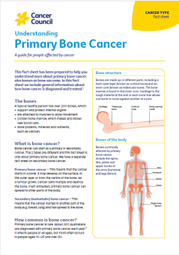- Home
- Primary bone cancer
- Symptoms
Primary bone cancer symptoms
The most common symptom is pain in the affected bone or joint that doesn’t improve with mild pain medicines such as paracetamol. You might have this pain most of the time, and it may be worse at night or during activity.
Other symptoms can include:
- swelling over the affected part of the bone
- stiffness or tenderness in the bone
- problems moving around, e.g. walking with a limp
- loss of feeling in the affected arm or leg (limb)
- bone that breaks for no reason.
These symptoms do not mean you have primary bone cancer. If you have symptoms for more than 2 weeks, you should see your general practitioner (GP).
More resources
Prof Peter Choong AO, Orthopaedic Surgeon, and Sir Hugh Devine Professor, St Vincent’s Hospital, and Head of Department of Surgery, The University of Melbourne, VIC; Catherine Chapman, Adolescent and Young Adult and Sarcoma Cancer Specialist Nurse, Division of Cancer and Ambulatory Support, Canberra Hospital, ACT; A/Prof Paul Craft AM, Medical Oncologist, Canberra Hospital and Australian National University, ACT; Belinda Fowlie, Bone Tumour Nurse Practitioner Candidate, SA Bone and Soft Tissue Tumour Unit, Flinders Medical Centre, SA; Prof Angela Hong, Radiation Oncologist, Chris O’Brien Lifehouse, and Clinical Professor, The University of Sydney, NSW; Vicki Moss, Nurse Practitioner, SA Bone and Soft Tissue Tumour Unit, Flinders Medical Centre, SA; A/Prof and Dr Marianne Phillips, Paediatric and Adolescent Oncologist and Palliative Care Physician, Perth Children’s Hospital, WA; Chris Sibthorpe, 13 11 20 Consultant, Cancer Council Queensland; Stephanie Webster, Consumer.
View the Cancer Council NSW editorial policy.
View all publications or call 13 11 20 for free printed copies.

